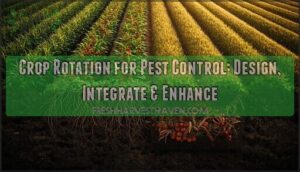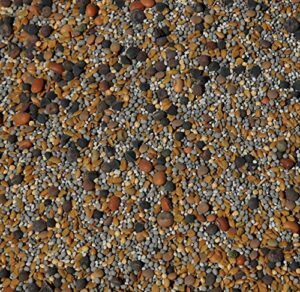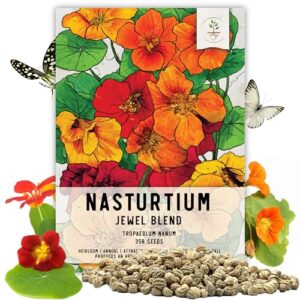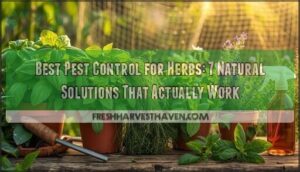This site is supported by our readers. We may earn a commission, at no cost to you, if you purchase through links.
A single nematode species can reduce tomato yields by 30% or more, yet rotating that same plot to corn for just one season can cut the population by 75%. This isn’t luck—it’s biology working in your favor. Most crop pests are specialists, meaning they’ve evolved to thrive on specific plant families.
When you systematically change what you grow, you pull the rug out from under these pests before they can establish themselves. Crop rotation for pest control leverages this vulnerability, disrupting reproduction cycles and forcing pest populations into decline without relying solely on chemical interventions.
The strategy demands more than simply alternating two crops, though. You’ll need to understand host-pest relationships, plan rotations that account for your local conditions, and integrate complementary practices that augment the effect.
Table Of Contents
- Key Takeaways
- How Crop Rotation Controls Pests
- Designing an Effective Crop Rotation Plan
- Integrating Crop Rotation in Pest Management
- Enhancing Pest Control With Cover Crops and Companions
- Challenges and Considerations in Crop Rotation
- Top Products for Crop Rotation Success
- Frequently Asked Questions (FAQs)
- Conclusion
Key Takeaways
- Crop rotation cuts pest populations by 50–82% by systematically removing host plants that specialist pests need to reproduce, forcing them to relocate or starve without relying on chemical controls alone.
- Three- to four-year rotation cycles deliver measurable results—reducing pest pressure up to 80%, cutting herbicide use by 88%, and preventing resistance development that undermines Bt crops and insecticides.
- Strategic pairing of cover crops and companion plants within rotations amplifies pest suppression, with studies showing marigolds reducing nematodes by 47% and diverse systems boosting beneficial insect populations by 114%.
- Effective rotation demands understanding which plant families share pest vulnerabilities, then mapping multi-year sequences that disrupt lifecycles while accounting for your local soil conditions, climate patterns, and economic constraints.
How Crop Rotation Controls Pests
Crop rotation works because it breaks the predictable patterns that pests and diseases depend on to thrive. When you rotate crops strategically, you interrupt the life cycles of harmful organisms, reduce their populations over time, and prevent them from adapting to your management tactics.
Let’s examine the three key mechanisms that make this practice such a powerful tool for pest control.
Disrupting Pest and Pathogen Lifecycles
When you rotate your crops strategically, you interrupt pest life cycles at vulnerable stages, denying them the continuous host plants they need to reproduce. This host removal creates a powerful form of lifecycle interruption that targets soil pathogens and specialist pests before they become problematic.
Here’s how breaking pest life cycles works in your fields:
- Sequential host removal forces specialist pests like corn borers to face non-host years, reducing populations by up to 80% as reproductive cycles collapse without preferred crops.
- Soil pathogen disruption occurs when you rotate away from susceptible crops, allowing natural die-off of Fusarium and similar diseases that can’t persist without their hosts.
- Brassica biofumigation releases glucosinolates during decomposition, suppressing nematodes and fungal pathogens by approximately 60% compared to continuous planting systems.
- Pest mobility limitations become advantageous—low-mobility insects show 68–76% reduced abundance when traps are placed just 10 km from previous host crops versus 1 km distances.
- Long-term suppression builds through diversified rotations, achieving 55–70% pest population reductions while simultaneously increasing soil organic matter by 10–18%, strengthening your fields against future infestations.
Crop rotation can also lead to improved soil health, further benefiting crop production.
By managing pest lifecycles through strategic rotation, you’re disrupting pest and pathogen cycles at their foundation, creating healthier growing conditions that reduce your reliance on chemical interventions while protecting crop quality season after season.
Reducing Pest Populations in Fields
Beyond breaking pest life cycles, you’ll see measurable drops in field pest populations through strategic crop rotation. Alternating nonhost crops forces specialist pests to relocate or perish, achieving 50–82% reductions in soil-borne pest populations across diverse rotation systems.
This rotation effectiveness transforms pest management by removing breeding grounds, while simultaneously improving soil health impact and delivering economic considerations that favor long-term profitability over reactive chemical treatments. Crop rotation is a key part of integrated pest management.
Preventing Pest Resistance Development
Reducing pest numbers also slows resistance mechanisms that undermine Bt crops and chemical controls. Integrated pest management frameworks depend on disrupting pest life cycles before populations evolve countermeasures, making rotation your frontline defense against economic impact.
When you rotate corn with soybeans, you cut severe rootworm damage by 92% while delaying adaptation to pest management tools. This rotation efficacy prompted regulatory mandates in 2016, protecting billion-dollar investments from resistance-driven losses.
Rotating corn with soybeans cuts severe rootworm damage by 92% and delays pest resistance, a strategy so effective it became federally mandated in 2016
Designing an Effective Crop Rotation Plan
Building a crop rotation plan that actually controls pests starts with understanding which crops attract which problems, and then strategically timing your plantings to break those cycles.
You’ll need to think beyond a single growing season, mapping out rotations that span multiple years while accounting for what your soil and climate can realistically support.
Let’s walk through the three core elements that make rotation plans work in the field.
Identifying Crop Families and Host Plants
The foundation of effective pest control starts with recognizing which plant families attract which garden pests. You need to understand that host specificity—the tendency of pests like Colorado potato beetles to target Solanaceae or cabbage loopers to attack Brassicaceae—drives rotation planning tools and success. Use taxonomic resources to map crop family traits, identify host plants, and disrupt pest life cycles through strategic sequencing:
- Group crops by botanical family (Solanaceae, Brassicaceae, Fabaceae, Poaceae, Cucurbitaceae) to track shared pest vulnerabilities
- Identify host-specific pests targeting each family using extension databases and field guides
- Document pest life cycles to time rotations that starve overwintering populations
- Leverage host plant resistance by selecting varieties within families that deter common attackers
Planning Multi-Year Rotation Cycles
A three- to four-year crop rotation cycle gives you measurable pest control—reducing pest pressure by up to 80% while cutting herbicide use by 88%. You’ll see yield stability rise 8–15%, though persistent soil pathogen levels demand five-year intervals for full suppression.
Rotation mapping by crop family ensures you’re disrupting pest and disease cycles systematically, balancing economic effects against the labor needed for complexity.
Integrating Local Climate and Soil Conditions
Regional climate impact and soil type effects shape rotation success more than you might expect. When you match crop sequences to local conditions, you’ll secure the pest control and productivity your farm needs.
Here are the key steps to consider:
- Assess climatic conditions: Temperature and rainfall patterns determine which rotation cycles suppress pests effectively in your region.
- Evaluate soil health: Soil organic carbon, pH, and texture influence how well rotations disrupt pathogen lifecycles.
- Adapt rotation length impact: Three- to four-crop cycles excel in temperate zones, while arid regions may need adjusted sequences.
- Address local pest pressures: Adaptive crop selection targets species dominant in your area, cutting pest populations while maintaining soil fertility.
These agricultural practices integrate challenges and considerations specific to your farm’s environment.
Integrating Crop Rotation in Pest Management
Crop rotation doesn’t work in isolation—it delivers the best results when you integrate it into a broader pest management strategy. By combining rotation with other sustainable practices and staying observant throughout the growing season, you can get the most out of pest suppression while maintaining soil health.
Let’s look at how to weave crop rotation into your overall approach and fine-tune it for consistent success.
Crop Rotation Within Integrated Pest Management (IPM)
You can’t manage pests effectively without weaving crop rotation into your integrated pest management strategy. The rotation efficacy depends on careful crop selection, strategic cycle length, and timing—digital IPM tools help you track pest populations and adjust schedules accordingly.
Real-time pest monitoring lets you adapt rotations based on seasonal pressure, and strategic cover crops boost both pest suppression and soil health for maximum crop rotation benefits.
Combining Rotation With Other Sustainable Practices
When you layer crop rotation with other sustainable agriculture practices, you realize pest control benefits that far exceed what any single method can deliver. Cover crop synergy with rotation boosts strawberry yields by 1,550 lb/acre, while intercropping benefits include 40% less nematode damage and 55% fewer disease outbreaks.
Companion planting within rotation cycles creates associational resistance, while legume cover crops supply nitrogen equivalent to 50% of synthetic fertilizer rates—demonstrating how integrated pest management and organic gardening principles multiply your pest suppression results.
- Biological control integration thrives in diversified rotations, supporting beneficial insects and reducing insecticide needs
- Precision tech use allows targeted chemical applications, protecting natural predators while enhancing rotation effectiveness
- Ecosystem service outcomes include 30–60% higher soil microbial activity and 70% fewer pesticide applications without yield loss
Monitoring and Adjusting for Best Results
You won’t know if your rotation is truly working without consistent monitoring technologies to track pest populations and crop health. Over 60% of mid-to-large-scale farms now use satellite or UAV imagery to detect pest pressure early, facilitating adaptive adjustments that cut pest-induced yield losses by 18%.
| Monitoring Approach | Key Benefit |
|---|---|
| NDVI satellite tracking | 15% productivity increase through early vegetation stress detection |
| UAV-captured imagery | 85% accuracy in pest risk period identification |
| AI-integrated platforms | 40% faster pest outbreak response versus manual scouting |
| Digital outcome documentation | Enables yearly rotation frequency adjustments based on measured pest data |
| Decision support systems | 17% greater pest suppression efficacy than calendar-based rotations |
Farms adjusting rotation frequency every 1–2 years based on monitoring data maintain Western corn rootworm below economic thresholds without routine insecticides. Real-time adjustment efficacy depends on flexible resequencing—introducing at least one non-host year disrupts pest life cycle disruption enough to achieve 70% population reductions.
Decision support platforms synthesizing pest monitoring, yield trends, and weather forecasts improve integrated pest management scheduling, yet implementation barriers persist. Over 30% of small farms still rely on manual assessments, and limited training affects timely crop rotation adjustments in 25% of operations, highlighting the gap between technology potential and field-level pest control outcomes.
Enhancing Pest Control With Cover Crops and Companions
Crop rotation becomes even more effective when you layer in cover crops and companion planting strategies. These additions work alongside your rotation schedule to suppress pests, attract beneficial insects, and build a more resilient growing system.
Let’s look at three practical ways to improve your pest control through strategic plant selection and biodiversity.
Benefits of Cover Crops for Pest Suppression
Cover crops serve as your natural pest control allies, disrupting pest lifecycles while boosting beneficial insects by up to 114% in studies. You’ll see measurable improvements in pest suppression through three mechanisms:
- Natural Enhancement – Predatory thrips populations increased 162–186% in buckwheat plots, establishing biological control.
- Population Reduction – Early-season pest density dropped more effectively than with chemical applications.
- Chemical Reduction – Pesticide emissions reaching soil decreased threefold, with ecotoxicity impacts lowering 65–90%.
These ecosystem services strengthen soil health and weed suppression naturally.
Mapping Companion Plants in Crop Rotations
Companion planting’s strategic value emerges when you map plant pairings within your rotation schedule. Spatial arrangement matters—marigolds alongside potatoes reduced nematode infestations by 47%, while calendula with broccoli cut aphid populations 58%. Temporal sequencing across crop families disrupts pest-host relationships each season, creating polyculture benefits that boost yields while confusing pests. Your mapped plan transforms rotation from simple alternation into targeted pest disruption.
| Companion Pair | Pest Reduction |
|---|---|
| Marigold + Potato | 47% nematodes |
| Calendula + Broccoli | 58% aphids |
| Thyme + Eggplant | 34% whiteflies |
Increasing Biodiversity for Natural Pest Control
Biodiversity transforms your fields into resilient pest-fighting ecosystems. Long-term grasslands boosted predation rates 23% in nearby crops, while diverse rotations lowered pest infestations 19%. Habitat restoration through wildflower strips and meadows delivers ecosystem services that strengthen natural pest control across your sustainable landscapes.
Build polyculture benefits strategically:
- Maintain grassland borders where beneficial insects thrive year-round, migrating into crops when pests appear
- Integrate woody habitats that shelter predators and parasitoids, cutting pest populations through sustained biological control
- Plant cover crop mosaics between rotations, increasing weed seed predation 16% while disrupting pest lifecycles naturally
Challenges and Considerations in Crop Rotation
While crop rotation offers powerful pest control benefits, you’ll face some practical hurdles when putting it into practice on your farm or garden. Space constraints, soil imbalances, and upfront costs can all challenge even well-planned rotation systems.
Let’s walk through three key considerations that’ll help you navigate these obstacles and make rotation work for your operation.
Overcoming Crop Rotation Limitations
Despite its benefits, crop rotation faces real-world hurdles. Pest adaptation can undermine efforts—for example, western corn rootworm populations evolved resistance, reducing control success from 98% to 60% over three decades. Landscape limitations, economic constraints favoring monoculture, and knowledge gaps in pest lifecycle timing further challenge effectiveness.
That’s why IPM integration becomes essential, combining rotation with monitoring and targeted interventions to outmaneuver pest infestations and soilborne diseases.
Addressing Soil Fertility and Nutrient Balancing
You can’t control pests effectively if your soil’s nutrient balance falls apart. Rotating legumes into your cycle boosts nitrogen fixation by 20–40%, cutting fertilizer needs while microbial activity increases by over 13%.
Smart rotation improves phosphorus retention, organic matter accumulation, and nutrient efficiency—often matching 75–91% of commercial fertilizer effectiveness.
Healthier soil means stronger plants that naturally resist pest pressure.
Evaluating Economic and Labor Factors
Revenue diversification through crop rotation boosts your farm income by an average of 20%, yet labor cost analysis reveals critical trade-offs you need to weigh carefully.
- Input cost reduction cuts pesticide use up to 50%, lowering economic risk
- Yield stability increases 10–32% in rotated systems versus monoculture
- Market access barriers and weak incentives slow adoption in some regions
- Reducing chemical inputs saves money while supporting sustainable agriculture
- Economic stability in farming improves through better pest management and resource efficiency
Top Products for Crop Rotation Success
Implementing crop rotation effectively often requires strategic selection of seeds and plant varieties that work together to disrupt pest cycles and build soil health. The right cover crops, companion plants, and rotation components can boost your pest management results while reducing your reliance on chemical interventions.
Here are four specific products that support successful crop rotation systems for improved pest control.
1. No Till Cover Crop Seed Mix
You’re looking for a practical way to strengthen your pest management arsenal while rebuilding your soil—that’s exactly where the No Till Cover Crop Seed Mix delivers. This 13-variety blend, inoculated with Rhizobium, enhances soil health by boosting carbon and nitrogen content while disrupting pest cycles through biodiversity impact.
The mix composition provides substantial weed suppression, reducing weed biomass by up to 20% compared to bare fields. At $15.99 per pound, it offers solid economic viability for raised beds and container gardens, supporting sustainable agriculture goals without excessive input costs.
Best For: Gardeners using raised beds or no-till containers who want to improve soil health, suppress weeds naturally, and attract beneficial insects without synthetic inputs.
- Reduces weed biomass by up to 20% and boosts soil carbon and nitrogen content, giving you healthier soil and fewer pest problems without extra work.
- The 13-variety blend with Rhizobium inoculation creates a biodiverse environment that attracts beneficial organisms and improves nutrient cycling naturally.
- At $15.99 per pound, it’s an affordable way to cut fertilizer costs long-term while building soil structure and resilience against drought.
- Birds and squirrels often eat the seeds before they establish, which can reduce coverage and force you to reseed or protect the area.
- One pound might not cover larger garden plots adequately, making it pricey if you need to scale up for bigger spaces.
- Requires moderate watering to establish properly, so it’s not ideal if you’re dealing with dry conditions or can’t water consistently.
2. NatureZ Edge Marigold Seeds Mix
You’re getting over 5,600 seeds for around $10—enough to cover 200 square feet with Petite French marigolds that mature in roughly 100 days.
These plants suppress soil-borne nematodes through root-exuded alpha-terthienyl, cutting tomato root galling when planted at least two months before your vegetable crop rotation.
Companion planting with tomatoes can drop whitefly settling by 40%, while attracting ladybugs, hoverflies, and parasitoid wasps for natural pest control.
Dense marigold planting creates physical barriers against garden pests, supporting integrated pest management strategies.
Best For: Gardeners who want affordable, large-scale pest control through companion planting and need a low-maintenance way to attract beneficial insects while suppressing nematodes in vegetable beds.
- Over 5,600 seeds for about $10 covers 200 square feet, making it one of the most cost-effective options for dense companion planting around tomatoes, peppers, and other vegetables.
- Roots release alpha-terthienyl that suppresses root-knot nematodes when planted two months before crop rotation, cutting tomato root galling in subsequent seasons.
- Attracts ladybugs, hoverflies, and parasitoid wasps while reducing whitefly settling on tomatoes by up to 40% in field trials.
- Requires full sun and moderate watering, with some risk of root rot in extreme weather or waterlogged soil.
- Not all marigold varieties suppress nematodes equally, and patchy planting reduces pest deterrence effectiveness.
- Can host its own pests like aphids and spider mites, so you’ll need to monitor and manage them to avoid creating new problems.
3. Fresh Organic Red Radish Bunch
At roughly $3 per bunch, this organic radish offers more than a fresh salad ingredient—it’s a strategic rotation tool that matures in 22 to 30 days, letting you reset your soil between vulnerable crops.
Radish taproots break up compaction in the upper profile while scavenging residual nitrate, preparing healthier beds for follow-up plantings.
Trap cropping studies show reductions up to 75% in squash bug eggs when radishes accompany susceptible hosts, and rapid turnover limits specialized garden pests from establishing damaging populations in your rotation cycle.
Best For: Home gardeners who want certified organic produce for fresh eating and those planning strategic crop rotations to improve soil health and naturally reduce pest pressure.
- Matures in 22–30 days for quick harvests and succession planting, letting you turn over beds fast between longer-season crops.
- Acts as a natural soil conditioner by breaking up compaction with deep taproots and scavenging leftover nitrate for healthier follow-up plantings.
- Functions as an effective trap crop that can cut squash bug egg counts by up to 75% when planted near vulnerable vegetables.
- Often arrives sandy or muddy, requiring multiple washes before you can use them in the kitchen.
- Quality varies from bunch to bunch—larger radishes can be woody or pithy instead of crisp.
- Costs more than conventional radishes or bulk non-organic options, which adds up if you’re buying regularly.
4. Jewel Mix Nasturtium Edible Flower Seeds
You can plant this $9.99 packet of 350+ seeds as both a trap crop and an edible flower resource. Nasturtiums drew aphids, flea beetles, and whiteflies away from primary crops, cutting pest damage by 57% in replicated mixed-plant beds. Their spicy scent confuses cucumber beetles and squash bugs, reducing infestation rates by 45%.
Beyond pest suppression, companion planting increased pollinator attraction by 16–23%, boosting nearby crop yields by 32%.
Edible flower uses span salads to garnishes, commanding market premiums. Seed availability peaks January through May for best cultivation practices in crop rotation cycles.
Best For: Home gardeners and small-scale growers looking for an edible, low-maintenance flower that doubles as natural pest control and attracts pollinators to boost vegetable yields.
- Acts as an effective trap crop that reduces pest damage by up to 57% while attracting pollinators that can increase nearby crop yields by 32%.
- Entirely edible flowers and leaves add peppery flavor to dishes and command premium prices in specialty markets, with harvest possible from May to October.
- Thrives in poor soil with minimal fertilizer needs, reducing input costs by 25% compared to nutrient-heavy crops while improving weed suppression by 39% with mulching.
- Struggles in hot weather and performs best when planted in cool spring conditions, limiting growing windows in warmer climates.
- Seeds may need soaking before planting and won’t germinate well in shaded or overcrowded spots, requiring some extra prep work.
- Plants naturally shed lower leaves as they grow and may need support structures if you want them to climb, adding maintenance tasks.
Frequently Asked Questions (FAQs)
What crops work best for beginner rotations?
Start with root crops like radishes or carrots, then rotate to legumes such as peas for nitrogen fixation.
Follow with brassicas, and complete your cycle with fruiting crops including tomatoes, incorporating cover crop options between seasons.
How does rotation affect beneficial soil organisms?
You’d think tilling and planting would disturb soil life, but rotation actually boosts it.
Microbial richness jumps 15%, earthworm populations double, and soil enzymes surge, strengthening nutrient cycling and creating healthier ecosystems below ground.
Can crop rotation eliminate pesticide use completely?
Pesticide elimination reality hinges on IPM integration, not rotation alone. While crop rotation excels against host-specific pests, host-range pests persist.
Economic viability improves through reducing chemical inputs, but complete pesticide elimination remains impractical in most sustainable farming practices.
What rotation mistakes lead to pest problems?
Like a broken lock inviting intruders, inadequate rotation intervals let pests return. Family misidentification, monoculture reliance, poor spatial planning, and ignoring resistance trends all compromise your crop rotation plan’s effectiveness against pest and disease cycles.
How long before rotation reduces existing infestations?
You’ll notice meaningful pest declines after one full rotation cycle for annual pests, but soil-borne pathogens require three to six years of non-host intervals for substantial population reductions below damaging thresholds.
Conclusion
When pest pressure becomes less than manageable, your rotation schedule is the leverage point. Crop rotation for pest control doesn’t eliminate every threat, but it systematically weakens the populations that would otherwise compound season after season.
Pair strategic sequences with monitoring protocols, and you’ll build resilience into your system rather than chasing outbreaks. The biology works—your job is positioning the right crops in succession, then letting specialist pests face the consequence of their narrow evolutionary path.
- https://farmonaut.com/blogs/how-does-crop-rotation-help-control-pests-shocking-facts
- https://www.stockholmresilience.org/research/research-news/2020-07-22-crop-rotation-mitigates-pest-resistance.html
- https://www.nature.com/articles/s43247-025-02418-7
- https://blog.plantwise.org/2025/06/06/how-does-crop-rotation-help-keep-pest-populations-in-control/
- https://www.sciencedirect.com/science/article/abs/pii/S0301479725018092














